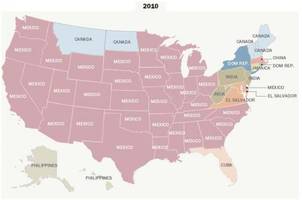 Several days ago, we looked at the big picture of US immigration, presenting the place of origin of America's 40 million foreign-born residents. However, as is always the case with the US, focusing on the big picture at the national level ignores the nuances at the state level.
Several days ago, we looked at the big picture of US immigration, presenting the place of origin of America's 40 million foreign-born residents. However, as is always the case with the US, focusing on the big picture at the national level ignores the nuances at the state level.The following two charts using Pew Research data, compiled by the WaPo, show the dramatic changes in the land of origin of US immigrants, beginning with 1910 when Germany was the primary driver of US-born residents, accounting for 18% of US immigrants, and proceeding through 2010, when Mexico has become the the biggest source of foreign-born residents: the birthplace of 29% of all immigrants in the US.
*1910:*
*and 2010:*
Some observations from WaPo:
*With more than 40 million immigrants, the United States is the top destination in the world for those moving from one country to another. *Mexico, which shares a nearly 2,000-mile border with the U.S., is the source of the largest wave of immigration in history from a single country to the United States.
But today’s volume of immigrants, in some ways, is a return to America’s past. A century ago, the U.S. experienced another large wave of immigrants. Although smaller at 18.2 million, they hailed largely from Europe. Many Americans can trace their roots to that wave of migrants from 1890-1919, when Germany dominated as the country sending the most immigrants to many of the U.S. states, although the United Kingdom, Canada and Italy were also strongly represented.
*In 1910, Germany was the top country of birth among U.S. immigrants, accounting for 18% of all immigrants (or 2.5 million) in the United States*. Germans made up the biggest immigrant group in 17 states and the District of Columbia, while Mexico accounted for the most immigrants in just three states (Arizona, New Mexico and Texas). Behind Germany, the second-most number of immigrants in the U.S. were from Russia and the countries that would become the USSR (11%, or 1.6 million).
Since 1965, when Congress passed legislation to open the nation’s borders, immigrants have largely hailed from Latin America and Asia. In states that have attracted many immigrants, the current share of immigrants is below peaks reached more than a century ago. Today there are four states (California, New York, New Jersey and Florida) in which about one-in-five or more people are foreign born. California peaked in 1860 at 39.7%, when China was the top country of birth among immigrants there. Meanwhile, New York and New Jersey peaked in 1910 at 30.1% (Russia and the USSR) and 26.2% (Italy), respectively.
Today, five times as many immigrants in the U.S. are from Mexico than China, the country with the second-highest number of immigrants (5% of all immigrants in the U.S., or 2.2 million). *Mexico is the birthplace of 29% (or 11.7 million) of all immigrants in the United States. Immigrants born in Mexico account for more than half of all of the foreign born in four states: New Mexico (72.4%), Arizona (60.2%), Texas (59.7%) and Idaho (53.5%).*
Of note: while until 1970, the percentage of US population that was foreign born steadily declined, reaching just 5%, over the past 40 years, as the organic growth rate of US-born population has declined below the rate of immigration, the percentage of immigrants as a % of total has been rising steadily and is now back to a level not seen in the past century.
Finally, here is why the Germans are losing to Mexicans, at least when it comes to US immigration by state: an animated map of German vs Mexican immigration from 1850 until modern days. Reported by Zero Hedge 8 hours ago.